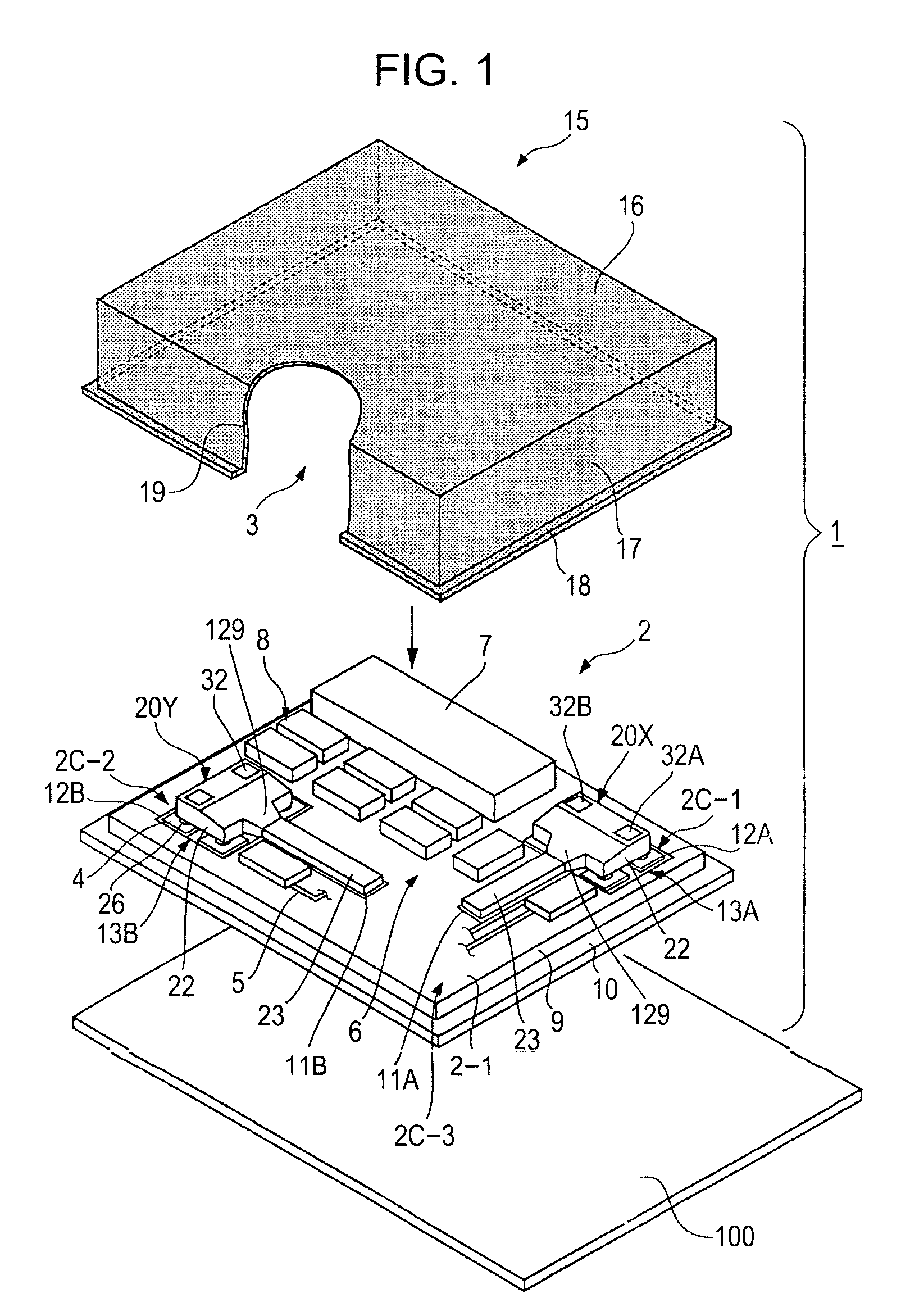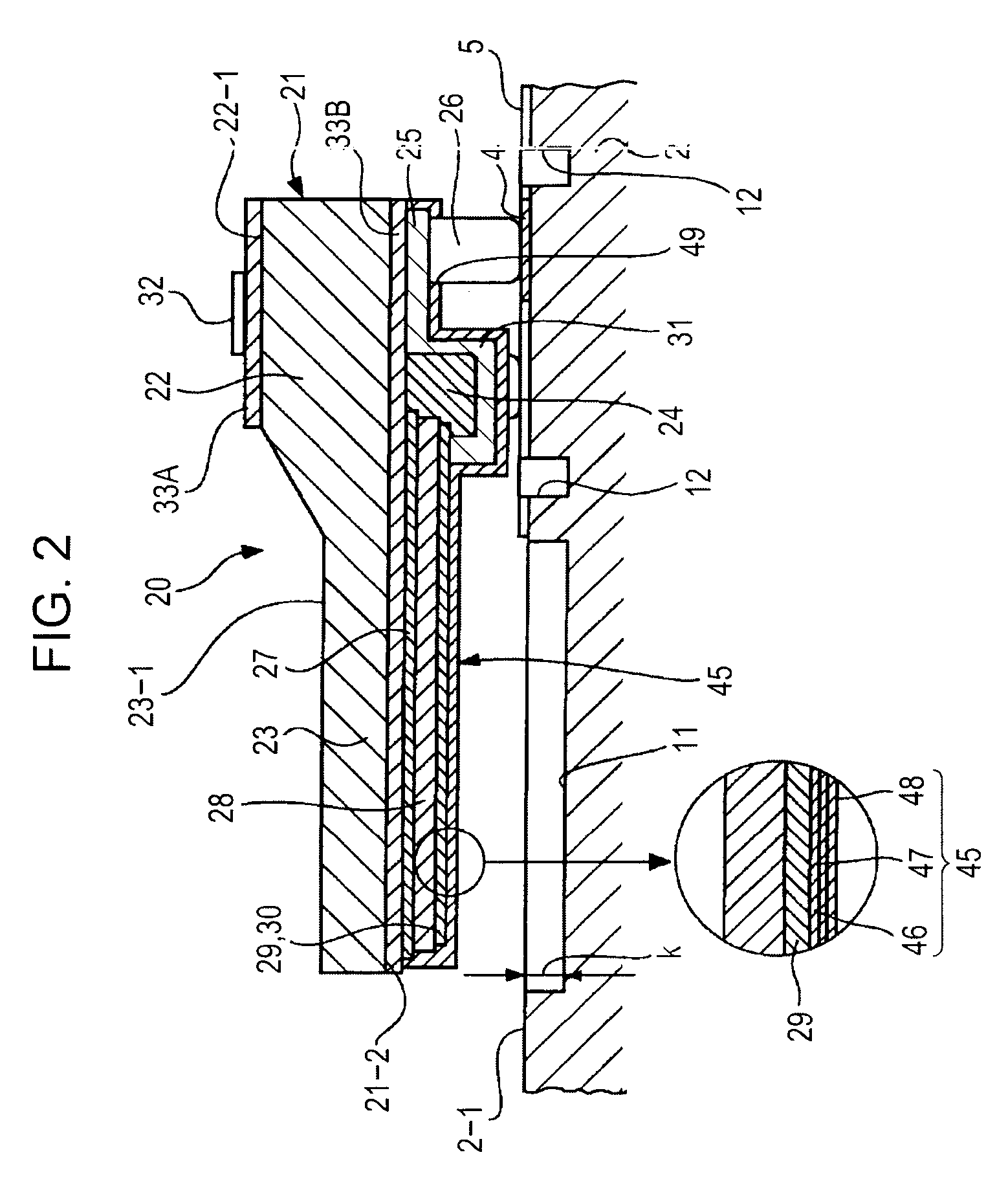Vibrating gyrosensor and vibrating element
a vibrating element and gyrosensor technology, applied in the field of vibrating gyrosensors and vibrating elements, can solve the problems of reducing reliability, difficult to maintain durability to mechanical external loads, and strong influence of external loads on vibration gyrosensors, so as to prevent broken, improve durability, and manufacture at low cost
- Summary
- Abstract
- Description
- Claims
- Application Information
AI Technical Summary
Benefits of technology
Problems solved by technology
Method used
Image
Examples
first embodiment
(Schematic Configuration of Vibrating Gyrosensor)
[0087]Referring to FIG. 1, a vibrating gyrosensor 1 has an exterior member including a support substrate 2 and a cover member 15 combined with a first main surface 2-1 of the support substrate 2 to form a component mounting space 3. For example, the vibrating gyrosensor 1 is mounted on a video camera to serve as a mechanism for correcting motion blurring. Also, for example, the vibrating gyrosensor 1 is used for a virtual reality device to serve as a motion detector or used for a car navigation system to serve as a direction detector.
[0088]The vibrating gyrosensor 1 includes, for example, a ceramic substrate or a glass substrate as the support substrate 2. Also, a predetermined wiring pattern 5 having a plurality of lands 4 is formed on the first main surface 2-1 of the support substrate 2 to form a component mounting region 6. In the component mounting region 6 are mixed-loaded a pair of first and second vibrating elements 20X and 20...
second embodiment
[0271]In the above-described first embodiment, the ICP-RIE (inductively coupled plasma reactive ion etching) method is used in the step of forming the outside groove 39 for cutting off the outer shape of each vibrator part 23 from the silicon substrate 21. This method is excellent in that a vertical groove is formed in the silicon substrate 21 at a high aspect ratio.
[0272]However, in use of the large silicon substrate 21 (large wafer diameter), as schematically shown in FIG. 48A, it may be difficult to form all vibrating parts 23 each having ideal vertical walls on both sides in the substrate. Namely, as schematically shown in FIG. 48B, the vibrator parts 23 having asymmetric shapes are formed in the peripheral region of the substrate due to a gas flow distribution, a plasma distribution, or the like in a plasma processing chamber.
[0273]When the vibrator part 23 has a symmetric shape, an ideal vibration mode in a vertical vibration direction occurs (FIG. 48A), and the detection sign...
third embodiment
[0286]In the above-described first embodiment, the ICP-RIE method is used in the step of forming the outside groove 39 for cutting off the outer shape of each vibrator part 23 from the silicon substrate 21. This method is excellent in that a vertical groove is formed in the silicon substrate 21 at a high aspect ratio.
[0287]When a linear groove is formed by general etching, an edge at a right angle (between the side in the groove width direction and the side in the groove length direction) is not precisely formed in the groove, and a curved edge is often formed. Therefore, in forming the outside groove 39, as shown in FIG. 51, the root parts 23R1 and 23R2 of the vibrator part, which correspond to the respective boundaries between the both sides of the vibrator part 23 and the side 22-3 of the base part 22, are formed in curved planar shapes. By using this etching property, the horizontal reinforcing part 129H is formed at the base end of the vibrator part 23 according to the first em...
PUM
| Property | Measurement | Unit |
|---|---|---|
| volume resistivity | aaaaa | aaaaa |
| angle | aaaaa | aaaaa |
| depth | aaaaa | aaaaa |
Abstract
Description
Claims
Application Information
 Login to View More
Login to View More - R&D
- Intellectual Property
- Life Sciences
- Materials
- Tech Scout
- Unparalleled Data Quality
- Higher Quality Content
- 60% Fewer Hallucinations
Browse by: Latest US Patents, China's latest patents, Technical Efficacy Thesaurus, Application Domain, Technology Topic, Popular Technical Reports.
© 2025 PatSnap. All rights reserved.Legal|Privacy policy|Modern Slavery Act Transparency Statement|Sitemap|About US| Contact US: help@patsnap.com



